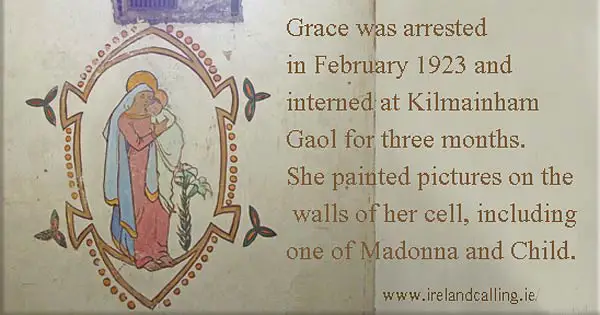Most people in Ireland had been indifferent to the Easter Rising and some actively opposed it.
However, the executions of the leaders helped to completely turn public opinion. The executions were seen by many moderate people as an extreme over-reaction. And heart-rending stories such as that that of Plunkett and Grace added to the sense of outrage and anger at what was seen as arrogance and brutality on the part of the British authorities.
Soon, people who had opposed the cause of Irish independence suddenly began to support it. The wave of public opinion became to strong to resist and the British quickly gave way. The Irish Free State came into being in 1922.
Plunkett didn’t see his dreams realised
The altar in the prison chapel where Plunkett and Grace were married was made in the 19th century by a prisoner called James Lawlor. Lawlor had been sentenced to seven years for “stealing the wheel off a cart”.
Plunkett and Grace had hoped to build a life together in that independent Ireland that they had worked so hard to create.
Sadly for them it was not to be. Following Plunkett’s death, Grace threw herself into her work as a commercial artist and in trying to promote the nationalist ideas of Sinn Fein. She became a member of the Sinn Fein executive in 1917.
Grace remained republican and was later arrested
Grace remained staunchly republican all her life and was arrested and sent to Kilmainham Jail herself in 1923.
Always the artist, she painted a picture of the Madonna and Child in her cell. It is still there today. She was released after three months and continued her work as an artist.
She provided the illustrations for The Words Upon the Window Pane, a collection of poems by W B Yeats.
In 1932, her work in support of Irish nationalism was recognised when she was awarded a pension by the Irish Government.

Grace had many admirers but never remarried
Grace enjoyed an active social life and although she had many suitors, she never remarried.
She continued living in Dublin and also travelled regularly to Paris where she enjoyed visiting the many art galleries.
Grace died in 1955 and was buried with full military honours in a republican plot at Glasnevin Cemetery in Dublin.
Click below for more about Joseph Plunkett and Grace Gifford
Joseph Plunkett and Grace Gifford early life
Easter Rising interrupted couple’s wedding plans
Couple’s tragic story helped shape public opinion
easter-rising.html
